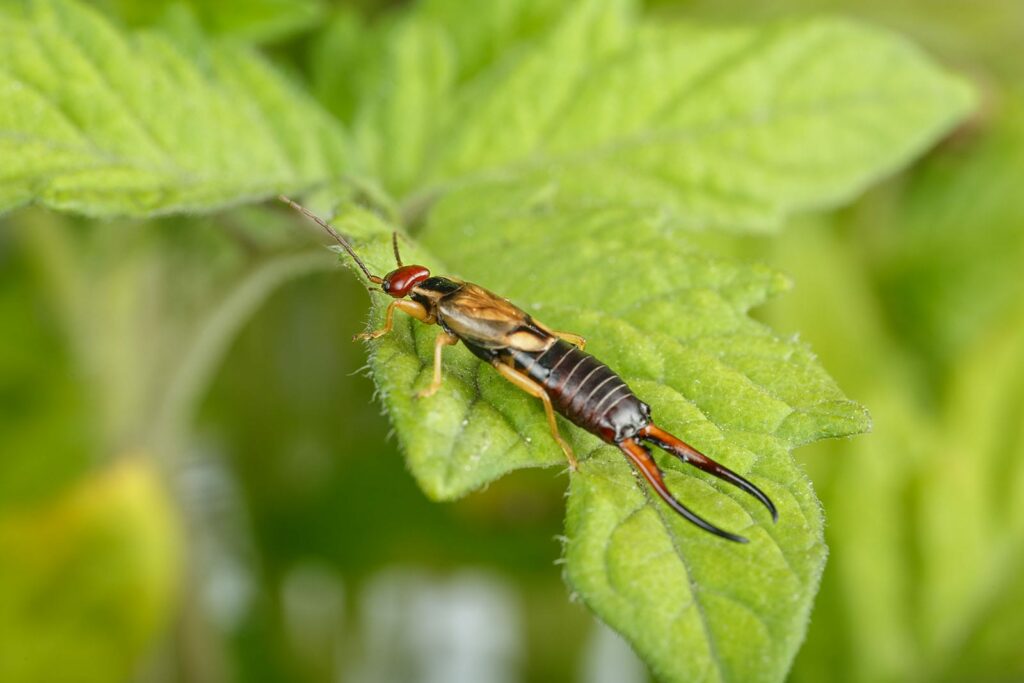
Contents
Some of us have been conditioned to jump when we see an insect we don’t like. This is true when that insect looks like it could do some harm. However, as much as you may not like to come across one, the earwig in your house is relatively non-threatening to humans.
To begin, let’s bust one big myth: the earwig DOES NOT crawl into a person’s ear. That falsehood was an old European myth, and there is no scientific proof to that behavior.
Earwigs have a flattened and elongated body that can be as long as one inch. This body can vary in color, varying from a pale brown with dark markings, to darker shades like a reddish brown or black. They have six legs and antennae are about half of its body length.
Most notable about the earwig are its pincers at the back of its abdomen. It primarily uses its pincers during reproduction, for hunting its prey, or for defense. For instance, if you try to pick up an earwig, it may attempt to pinch your finger. The pinch itself might be a little painful, but no venom or disease is transferred and it isn’t likely that the pinch will break your skin.
Earwigs do have two sets of wings that usually fold on top of the other. There are over 20 different species of earwigs in the United States, but not all of them can fly. Those that can will do so only in small bursts.
The earwig prefers to live outside where it can find food and plenty of moisture. They will feed on leaves, flowers, fruits, mold, and even some insects. Feeding usually occurs at nighttime, and the earwig will spend its day hiding in cold, wet areas where it can be undisturbed.
There are certain types of earwigs that will target seedlings for its food. So while the earwig is not a threat for humans, it can damage your garden by rendering crops and plants unproductive. When the need for food is greater, that is when you will see earwigs come into your home.
Like many other small pests and insects, the earwig will gain entry via cracks or other openings. They will seek a water source, like a bathroom, laundry room or kitchen, but have also made their way into bedrooms or living rooms. If you uncover or startle an earwig, then its reaction will be to scurry away quickly.
Getting rid of earwigs means you should get rid of their favored habitat. Remove piles of leaves, mulch or other vegetation from your property, and keep firewood stored away from your home. Cut back trees or shrubs that can create damp, shaded areas, and be sure your gutters and downspouts can flow properly to avoid unwanted buildups of moisture.
Even though the earwig does not pose a major threat to you or your family, you certainly don’t want to see it scurry through your household. When you need help to remove them, and keeping them out, that is when you will want to call the professionals at Van Den Berge Pest Control at 616-392-7367.
Trust the locally owned, widely renowned experts at Van Den Berge Pest Control for all of your pest needs. With over 100 years of combined experience throughout the Holland, MI-based pest control team, you know you’re in excellent hands with our state-certified experts.
Recent Posts
Comparing Top Flea Extermination Services for Pets
Imagine your friend’s dog, Max, scratching incessantly and suffering from a flea infestation. It’s a
5 Best Indoor Pest Control Strategies for Homes
Imagine walking through your home, only to spot an unwelcome visitor scurrying across the floor.
7 Essential Tips for Professional Flea Extermination
You might think tackling a flea infestation is overwhelming, but it doesn’t have to be.
